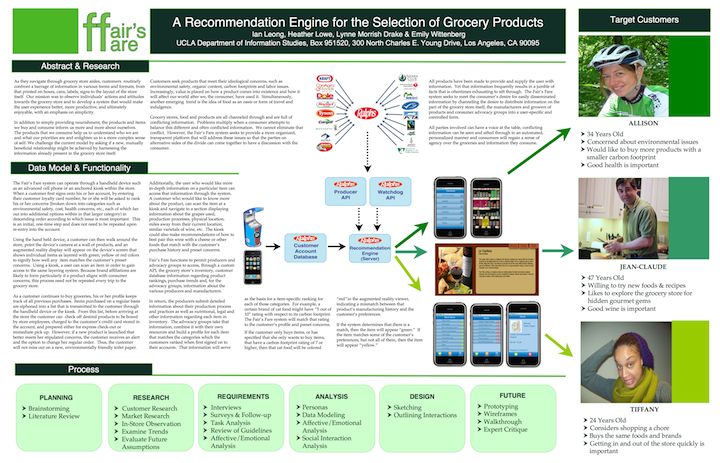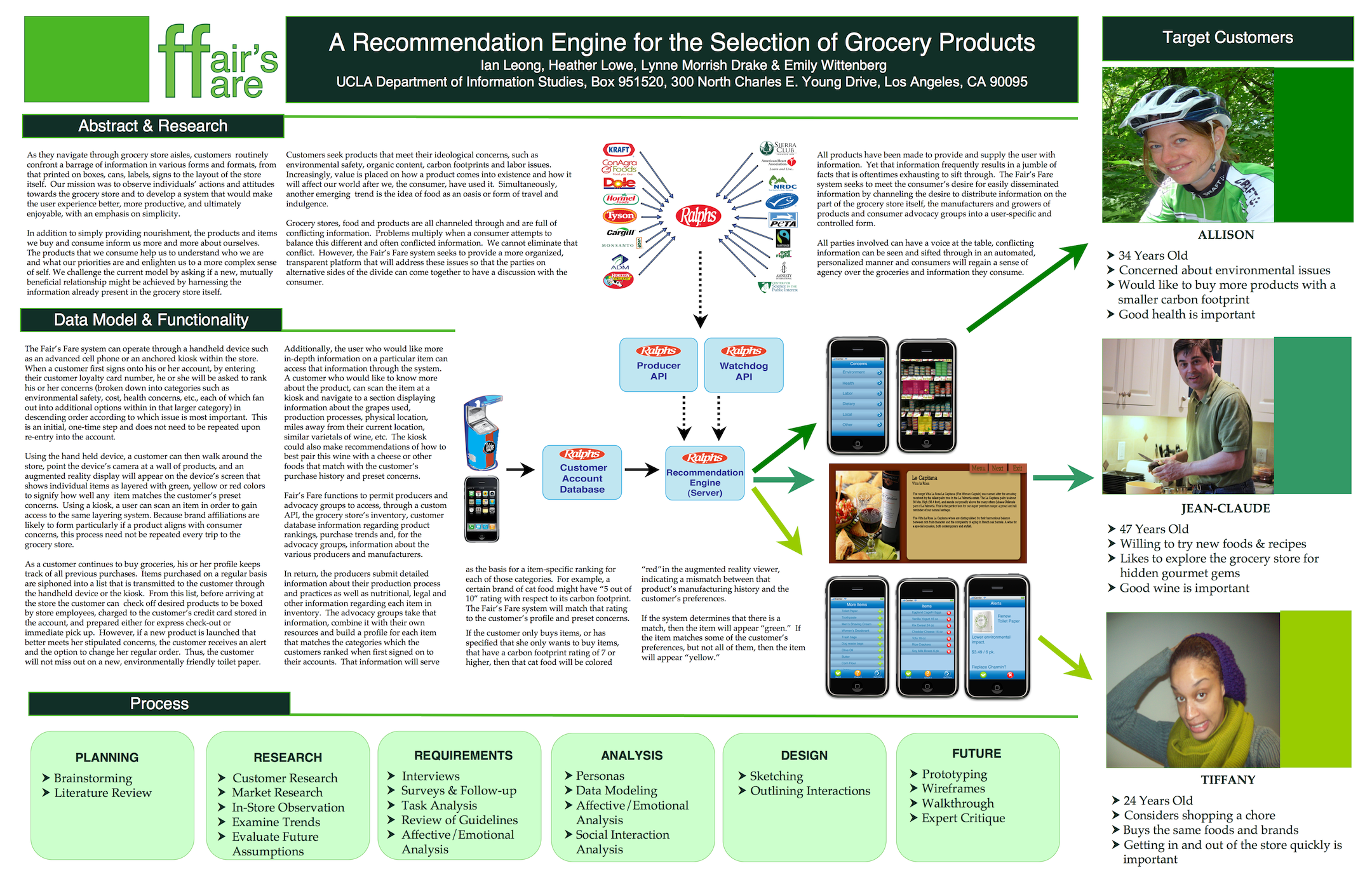Fair's Fare: A Recommendation Engine for the Selection of Grocery Products
Project Team: Ian Leong, Heather Lowe, Lynne Morrish Drake & Emily Wittenberg
(click on image to enlarge)
Abstract:
1. INTRODUCTION
Food consumption, purchase, and interacting with information about food are integral components of our daily lives. Grocery shopping and grocery stores are primary channels through which we as a society gain access to food and food information. As they navigate through grocery store aisles, choosing products, checking shopping lists and thinking about recipes, customers routinely confront a barrage of information in various forms and formats, both direct such as that printed on boxes, cans, labels, signs and indirect such as the layout of the store itself. Our mission was to observe individuals actions and attitudes towards the grocery store and to develop a device or system that would make the user experience better, more productive, and ultimately enjoyable, with an emphasis on simplicity.
2. DESIGN IN A GROCERY STORE
How is design integrated into a grocery store one might ask? The shortest answer is to list where it is not in a grocery store. Design and information surround patrons, employees and other users in a grocery store. Parking lot accessibility, lighting, product placement, store layout and pricing signs guide the customers through the store and impact their relationship with food and other goods. In addition to simply providing nourishment, the products and items we buy and consume inform us more and more about ourselves. The products that we consume help us to understand who we are and what our priorities are and enlighten us to a more complex sense of self. A typical grocery stores mission is to profit by selling products to customers. We challenge the current model by asking if a new, mutually beneficial relationship might be achieved by harnessing the information already present in the grocery store itself. What if a new design approach were taken, one giving the grocery store user agency over his or her shopping experience, one that increases the transparency of information and creates a less chaotic, more pleasant experience? User-centered system design belongs in a grocery store because the services such a place provides are integral to our lives, habits, ideologies and health needs. Illustrating new design approaches in which the user is the central focus is paramount to creating better relationships between consumer, information and food products.
3. IDENTIFYING TRENDS
Recent trends suggest people at the grocery store desire value beyond price differences. Customers seek products that meet their ideological concerns, such as environmental safety, organic content, carbon footprints and labor issues. Increasingly, value is placed on how a product comes into existence and how it will affect our world after we, the consumer, have used it. Simultaneously, another emerging trend is the idea of food as an oasis or form of travel. For example, buying products to create an Italian meal could transport the consumer from his or her mundane life to the vineyards of Naples. Likewise, browsing and consumption of ethnic goods and markets also indulge customers, providing them with pleasurable experiences as they explore new and unique products.
4. RESEARCH METHODS
Designing a system requires diverse methods to solicit authentic responses. Observing, identifying trends, surveying users, collaborating, researching, developing and discarding concepts, sketching and creating mockup prototypes were various methods used to delve into the issue of the relationship between grocery stores and consumers. Collaborating and sketching as a unit provided us with our best results when attempting to design a device or information system for our domain as the sketching helped the group to visual a group members spoken proposals. Researching current trends and gaining user input through surveys and informal conversations allowed us to push beyond our preconceptions of grocery stores, food information, emotional responses and ideological concerns to shopping.
5. PROPOSED SYSTEMS
Our information system is designed to remove the chaos from the customers experience of shopping by filtering items according to his or her preferences. Our system can operate through a handheld device such as an advanced cell phone or an anchored kiosk within the store. When a customer first signs onto his or her account, by entering their customer loyalty card number, he or she will be asked to rank his or her concerns (broken down into categories such as environmental safety, cost, health concerns, etc., each of which fan out into additional options within in that larger category) in descending order according to which issue is most important. This is an initial, one-time step and does not need to be repeated upon re-entry into the account.
Using the hand held device, a customer can then walk around the store, point the devices camera at a wall of products, and an augmented reality display will appear on the devices screen that shows individual items as layered with green, yellow or red colors to signify how well any item matches the customers preset concerns. Using a kiosk, a user can scan an item in order to gain access to the same layering system. Because brand affiliations are likely to form particularly if a product aligns with consumer concerns, this process need not be repeated every trip to the grocery store.
As a customer continues to buy groceries, his or her profile keeps track of all previous purchases. Items purchased on a regular basis are siphoned into a list that is transmitted to the customer through the handheld device or the kiosk. From this list, before arriving at the store the customer can check off desired products to be boxed by store employees, charged to the customers credit card stored in the account, and prepared either for express check-out or immediate pick up. In this way, the customers profile might alleviate some of the drudgery associated with grocery shopping allowing the consumer to focus on exploring new products or finding ingredients for specific recipes. For example, if a customer buys milk, eggs, and toilet paper on a bi-weekly basis, these items will be siphoned into the list of items to be boxed. However, if a new product is launched that better meets her stipulated concerns, the customer receives an alert and the option to change her regular order. Thus, the customer will not miss out on a new, environmentally friendly toilet paper.
Although users do not need to reconfigure their concerns upon re-entry into the system, they can modify their settings according to their changing concerns. An individual whose primary concern was, at one time, cost can alter his preferences if health becomes an issue and he needs to buy healthier items instead of the cheapest ones. Additionally, the user who would like more in-depth information on a particular item can access that information through the system. For example, a customer who buys a 3 Blind Moose Cabernet but would like to know more about the product, can scan the item at a kiosk and navigate to a section displaying information about the grapes used, production processes, physical location, miles away from their current location, similar varietals of wine, etc. The kiosk could also make recommendations of how to best pair this wine with a cheese or other foods that match with the customers purchase history and preset concerns. The system will thereby function to give the customer greater access to more detailed facts about a product at the same time that it personalizes that information so as to provide a sense of control over that information.
6. CONCLUSION
Grocery stores, food and products are all channeled through and are full of conflicting information. Problems multiply when a consumer attempts to balance this different and often conflicted information. We cannot eliminate that conflict. However, our system seeks to provide a more organized, transparent platform that will address these issues so that the parties on alternative sides of the divide can come together to have a discussion with the consumer. All products have been made to provide and supply the user with information, yet that information frequently results in a jumble of facts that is oftentimes exhausting to sift through. Our system seeks to meet the consumers desire for easily disseminated information by channeling the desire to distribute information on the part of the grocery store itself, the manufacturers and growers of products and consumer advocacy groups in a user-specific and controlled form. Thereby, all parties involved can have a voice at the table, conflicting information can be seen and sifted through in an automated, personalized manner and consumers will regain a sense of agency over the groceries and information they consume.
